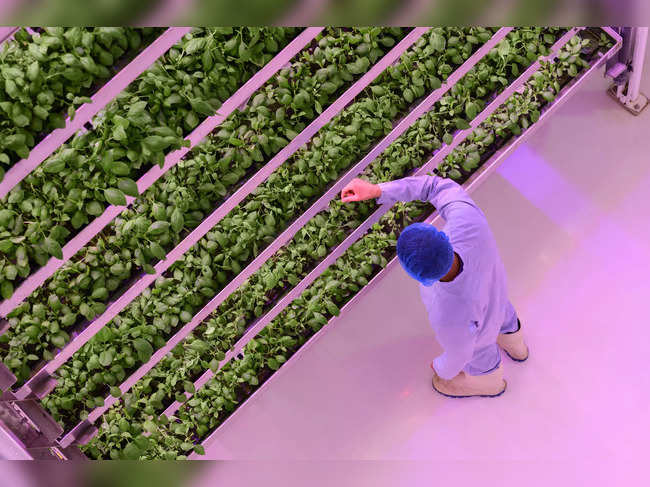 iStock
iStockIt's a fresh-veggie crisis and United Natural Foods, Inc., a grocery wholesaler that distributes food to 30,000 locations across North America, has a solution. Next year it will open an indoor high-tech vertical farm devoted to herbs and other greens in the parking lot of one of its Wisconsin distribution centers. The concept of indoor farming has been around and expanding for years. But thanks to technological advances and consumer demand for reliable sources of locally grown foods, a new generation of enclosed farms is poised to change what consumers buy and eat.
Indoor growers aren't required to label how their produce is grown, though, so many consumers have no idea that they're buying into a food revolution. Long term, that's a recipe for mistrust and accusations of “factory farming.” Fortunately, that can be avoided with something as simple as a voluntary approach to labeling products so that consumers associate them with sustainability, localisation and flavor.
In the mid-20th century, scientists in California developed electrically lit, climate-controlled facilities in which crop yields exceeded those achieved outdoors. Unfortunately, the power demands of these controlled environments made them too expensive to be commercially viable, especially compared to traditional field agriculture.
But interest in developing controlled-environment agriculture — or CEA, as it's known today — didn't subside. In the 1970s, innovators determined to bring agriculture into urban areas developed vertical farming, a technique in which layers of crops are stacked in climate-controlled indoor facilities. Soil is typically replaced by nutrient-rich hydroponics and aeroponics (roots are exposed and bathed in a mist) and water is recycled, boosting sustainability and yields beyond what can be achieved outdoors. Meanwhile, light is provided by energy-efficient, low-cost light emitting diodes, or LEDs. By the mid-2010s, costs associated with CEA had fallen so drastically that leafy greens grown in CEA facilities had become price-competitive with organic greens grown in the fields of California.
These days, there are more than 2,000 vertical farms in the US, and many have opted to move their technologies, micro-climates and crop stacks into insulated, shipping container-size modules. Brooklyn-based Square Roots, founded in 2016, operates a technology platform that incorporates automated seeding, harvesting and sanitisation. Meanwhile, software manages every aspect of the growth cycle, allowing the company to control more than 100 different parameters that "customise" the produce. Tobias Peggs, CEO at Square Roots, told me during a call that if a restaurant chef requests a spicier arugula, Square Roots can grow it. “And if the chef says, ‘Whatever you did there, it’s amazing,’ we can push that instruction out to the other modules.”
That hyper-localisation of production has benefits beyond specialty restaurant kitchens. Thanks to extreme, variable weather caused by climate change, some of the world's most important agricultural regions are experiencing dropoffs in agricultural production. For example, the ongoing drought in California, the worst in recorded state history, idled 750,000 acres of irrigated land this year — an area more than 50 times greater in size than Manhattan. For consumers, that’s meant reduced supply and skyrocketing prices for romaine and other vegetables.
But interest in locally sourced food began long before drought and Covid disruptions. The farm-to-table movement of the 1970s advanced the idea that local produce is fresher and tastier because it doesn't need to be trucked from California to, say, Wisconsin. The problem, of course, is that Wisconsin's traditional farmers are limited in their ability to grow most crops that thrive in California.
Those limits don’t apply to indoor growers outfitted with climate-controlled modules that run all year long. UNFI, a major wholesaler of natural and organic foods to retailers, including Amazon.com Inc.-owned Whole Foods, noticed. It invited Square Roots to set up a 20,000 square-foot farm at one of its distribution centers near the Twin Cities. Produce grown there will be distributed to hundreds of outlets in Minnesota and Wisconsin.
These high-tech artificially lighted farms may not be what many consumers envision when they think of "locally sourced" greens, but they’re contributing to a more resilient supply chain of fresher food that doesn't require extensive trucking — among the key goals of the grow-local movement. Farms located at distribution points also provide economies of scale that can't be achieved by locating smaller indoor farms at individual supermarkets. Some analysts project that the industry could be worth more than $33 billion by the end of the decade.
Nonetheless, even the most enthusiastic advocates don’t expect indoor farms to replace outdoor agriculture. There will never be the capacity indoors to replace vast fields of wheat and rice, for instance. Even most traditional salad ingredients, such as iceberg lettuce, won’t move inside anytime soon, says Dorn Wenninger, vice president of produce at UNFI. From a business standpoint, the key opportunity is to steady supply chains that are increasingly strained and broken and to provide consumers with fresher greens than they're used to getting at the supermarket.
The missing ingredient is a label explaining to consumers what they're buying. For years, shoppers have become acclimated to "organic" as both information and marketing. In some cases, "organic" and "indoor" can be used synonymously. But indoor agriculture has benefits that "organic" doesn't capture (such as reduced land use), and challenges that require explaining (power draw for indoor lighting remains a challenge). An industry-wide voluntary labeling standard that promotes the benefits of this new produce — for example, how much water was used — while being transparent about its impacts by acknowledging carbon usage would be an excellent means of promoting it beyond a niche.
For consumers worn down by shortages and inflation, that would be a welcome harvest.
(Catch all the Business News, Breaking News, Union Budget 2024 Events and Latest News Updates on The Economic Times.)
Subscribe to The Economic Times Prime and read the ET ePaper online.
Read More News on
(Catch all the Business News, Breaking News, Union Budget 2024 Events and Latest News Updates on The Economic Times.)
Subscribe to The Economic Times Prime and read the ET ePaper online.











 Get Unlimited Access to The Economic Times
Get Unlimited Access to The Economic Times
